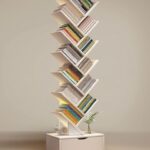Libraries are fantastical, filled with tales that can be found. But have you ever paused to consider the unnoticed literary heroes of these literary havens? We are talking about library shelves, yes. Such structures do not merely contain books, but define our relations with information and ideas.
A properly planned library shelf is capable of transforming an unorganized pile into a paradise. It enables customers to move around without much difficulty, locate their next favorite book, and even experiment with new genres without getting irritated. We shall explore the concept of a library shelf that is actually functional and how it improves the whole experience of all people who pass through the doors. It does not matter whether you are creating a home library or a library makeover in a community, the nature of good shelving is the main issue.
The Purpose of Library Shelves
The shelves in a library are the foundation of the library. They are not merely storage facilities but they provide a place that knowledge can thrive.
Fundamentally, shelves offer structure. They systematize materials in such a manner that encourages exploration and discovery. A properly placed shelf enables a reader to locate what (s)he wants; a favorite classic or a new bestseller.
These are also spaces that promote browsing. Having books displayed in an attractive way tempts patrons to draw the titles which they would have not drawn otherwise. Such an accidental meeting with new ideas enhances the process of reading.
In addition, a library book shelf reflects the values and interests of the community. The selection of materials and their organization represent diverse voices, making literature accessible to everyone.
Good shelving is based on functionality and at the same time creates beauty. It is based on the establishment of a welcoming environment that generates curiosity and leads to life-long learning.

Factors to Consider When Designing Functional Library Shelves
Not all library shelves are made by piling books. It involves being keen on a number of factors to increase usability and accessibility.
To begin with, shelf height and width are very important factors. The taller units are able to maximize the vertical space but not everybody may be able to afford it. It is important to have a balance between reachability and storage capacity.
Then, there is the construction materials. Good, robust materials will be durable and will not need replacement easily, and have an aesthetic value. Wood provides the coziness whereas metal gives modernity; each has its own merits.
Flexibility is also a big issue. The shelves can be adjusted to suit the needs of the collections as the collections evolve with time. Such flexibility can ensure space is put to the best use without compromising style.
Consider user flow in the library setting. The display shelves must be user-friendly and satisfy the user to find their desired items easily without being overwhelmed by an assortment of items in disorderly heaps scattered across them.
Utilizing Space Effectively
Utilizing library shelf space in a maximum way can turn the library around and make the library experience more rewarding to both customers and employees. The design should be well considered so that materials can be readily accessed and they should look well organized.
Think over the vertical storage. Elevated shelves make use of the height and provide more capacity without consuming more space on the floor. The provision of adaptable shelving gives the opportunity of flexibility in the size of books and the shelving can fit all sizes of books such as paperbacks and large reference books.
The strength of modular units should not be ignored. The versatile pieces can be re-purposed when the needs vary and hence the library is able to evolve.
Use multi-functional furniture where appropriate. Tables containing inherent storage or seating that convert to shelving make them more useful and ensure that areas are kept clean.
Never forget about flow – the way people circulate in the library affects functionality. Make avenues that make exploration appealing and the products that are in high demand to be readily available in the right places.
Organization and Categorization of Materials
A proper library shelf is a must to a smooth experience. When the material is sorted in a proper manner locating certain books or resources becomes a very easy task.
Consider dividing items by genre, subject, or author. This does not only assist in the process of navigation, but also improves the browsing process of the patrons. The various categories have their own story to tell, in terms of carefully chosen selections.
It is possible to use color-coded labels to further differentiate areas. Visual cues enable the user to save time as they can be able to determine where they want to go without struggling to find a direction.
Furthermore, the use of digital resources, such as inventory systems, can facilitate the work on tracking and sorting of materials. This simplifies the work of the librarians in controlling collections and keeping everything current.
Designing a logical run on shelves stimulates exploration and discovery of the readers. A user-friendly layout encourages users to explore further into the things that they find interesting.
Durability and Maintenance
The factors of durability and maintenance play a major role in developing an effective library shelf. These shelves will be loaded with the books and materials after all, and the weight is going to be quite a lot in the long run. It is necessary to select quality materials to last long. Hardwood or durable metal will be able to withstand everyday use much more than the weakly built ones.
Maintenance is also very important. Shelf dusting is often used to avoid the accumulation that may potentially cause its wearing out. Further, proper binding of shelving units reduces the chances of falling accidents or capsizing particularly in crowded places such as libraries.
Taking time to make sure that your shelves will not wear out or have any tears not only extends your shelf life, but also makes them look their best. A clean environment encourages a visitor to enjoy its resources in greater liberty making the setting conducive to building knowledge.
Once you mix durability with mindful design, you make the place very welcoming, which will make the patrons interested in learning and exploring everything which makes all of your visits worth having. Such a combination of usability and beauty eventually turns into the common library spaces into something extraordinary, the doorways into knowledge.











Leave a comment